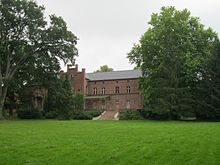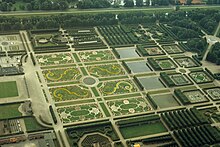Udo von Alvensleben (art historian)
Udo August Ernst von Alvensleben (born January 23, 1897 in Wittenmoor , † August 22, 1962 in Bodelschwingh ) was a German art historian .
family
Udo von Alvensleben came from the Altmark noble family von Alvensleben and was the eldest son of the landowner, Prussian chamberlain, manor house member and district deputy Ludolf Udo von Alvensleben (1852–1923) on Wittenmoor, Sichau-Tarnefitz and Plutowo, and Ida von Alvensleben. von Glasenapp (1866–1924). His youngest brother was the officer Wichard von Alvensleben (1902–1982), who became known for the liberation of prominent SS hostages at the end of April 1945. His middle brother Ludolf Jakob von Alvensleben was an SS and police leader in Italy .
In 1944 he married Elma Freiin zu Innhausen and Knyphausen (1919–2004) from Bodelschwingh . This marriage resulted in three children, including the ambassador Busso von Alvensleben (* 1949).
Educational path
In 1914 he graduated from the Knight Academy in Brandenburg Cathedral . From the First World War, in which he was mainly deployed in northern France and Flanders, he returned as a first lieutenant. From 1919 he studied agriculture and forestry, history, art history and philosophy in Munich. He also took lessons in drawing, etching and lithography.

In 1920 he took over the management of the Wittenmoor estate and continued his studies in Berlin, which he expanded to include law, economics, diplomacy and archeology. Diary entries show those shaped by war experiences as intellectually and spiritually seekers; In 1926 he visited Romain Rolland in Villeneuve on Lake Geneva. In 1926 he went to Hamburg and received his doctorate in 1927 at the art historian Erwin Panofsky to Dr. phil. His dissertation on the Great Garden in Hanover-Herrenhausen was published by Deutsches Kunstverlag and provided the inspiration for its reconstruction from 1936, on which he assisted in an advisory capacity.
This was followed by trips to Europe, especially to France, which influenced his love for the Baroque for a lifetime, and trips around the world that took him to America and Asia. In 1927/28 he traveled to India with his cousin, the Indologist Helmuth von Glasenapp . During his stays in China and Japan in 1932/33 he was primarily concerned with their philosophy as well as Chinese and Japanese garden art . One of his friends was Hans-Hasso von Veltheim- Ostrau, who tried to convey Indian teachings to Germany.
Further life


Like many of his ancestors, he had geared his broad-based educational path towards engaging in civil service. When the National Socialists came to power, he returned to more private projects. Through his studies of palaces and gardens from the Baroque period, he came to an ever more intensive preoccupation with the historical and cultural heritage of his family. The baroque park of what was once Alvensleben 's Hundisburg Palace was also reconstructed by him on behalf of the owner. In 1937 he published a book about the architect von Hundisburg, Hermann Korb , and his palace buildings in Brunswick. From 1935 he initiated the restoration of Friedrichswerth Palace .
Extensive collections of written and photographic material were created. On his behalf and on the basis of his preparatory work, the Dutch painter Anco Wigboldus drew all Alvensleben houses in the baroque style of a bird's eye view, after he had visited them with his company and determined their condition under his guidance over the centuries. The park and manor house in Wittenmoor experienced a heyday in their development with numerous guests, lively intellectual exchange and lots of music. In 1936 Alvensleben had to give up part of its forest areas for the construction of the Altmark military training area and in 1937 acquired Gut Keez (district of Brüel ) near Schwerin in Mecklenburg, which offered him an additional economic and creative challenge.
During the Second World War he served as a soldier in Poland, France, Russia, the Balkans, Italy and finally Norway. His diary during the war (excerpts published in 1971 under the title “Lauter Abschiede”) reports on it. Together with the then Stendal superintendent Hermann Alberts , he saved the valuable medieval stained glass in Stendal Cathedral by having them stored in the Wittenmoor manor during the war.
After the expropriation of his property through the so-called land reform in the Soviet-occupied zone in 1945, he lived as a refugee in his wife's parents' house, Haus Bodelschwingh near Dortmund. He kept himself and his family afloat with lectures on cultural history and commissioned publications. Soon agricultural and forestry duties came up again when his wife inherited the small neighboring estate of Haus Rodenberg .
Alvensleben was a member of forestry committees, the Swedish-German Refugee Aid and the Central German Cultural Council, organized conferences, advised on the restoration of historical gardens and continued his intensive research work. His publications from this period include a. "The Lütetsburger Chronik", the story of the Frisian chief family Knyphausen, and "Alvensleben castles and country estates". He made a significant contribution to the fact that the von Alvensleben family resumed their family reunions, which began in 1479, after the expulsion in 1945, that the rescued parts of the Alvensleben fief library from the 16th century were secured in their holdings and that the legendary, medieval family ring was given a storage location corresponding to its importance . After reunification, the ring was entrusted to the cathedral treasury in Halberstadt, the episcopal city that is closely connected to the origins of the family.
Alvensleben kept an extensive diary from 1914 to 1962, which after his death Harald von Koenigswald compiled and published parts of Schlösser books and a war diary. These are fascinating cultural and historical testimonies of strong personal expressiveness and judgment.
Works
- Herrenhausen, The summer residence of the Guelphs ( Deutsche Lande - German Art ), Berlin 1929
- The Braunschweig castles of the baroque period and their master builder Hermann Korb , Berlin 1937
- The Lütetsburger Chronik, history of a Frisian chief family, Dortmund 1955
- Alvensleben castles and country estates, Dortmund 1960
- Memoirs, unpublished manuscript
- Visits before the sinking, noble seats between Altmark and Masuria , from diary entries by Udo von Alvensleben, compiled and edited by Harald von Koenigswald, Frankfurt / M.-Berlin 1968. New edition: When they still existed ... noble seats between Altmark and Masuria. Ullstein, Berlin 1996, ISBN 3-548-35641-9
- Walls in the current of time, castles and fates in Lower Germany, from diary entries by Udo von Alvensleben, compiled and edited by Harald von Koenigswald, Frankfurt / M.-Berlin 1969
- Palaces and fates, manors and fortresses between the Danube and the Rhine, from Udo von Alvensleben's diary entries, compiled and edited by Harald von Koenigswald, Frankfurt / M.-Berlin 1970
- Lauter Abschiede, Diary during the war, edited by Harald von Koenigswald, Propylänen Verlag, Berlin 1971, ISBN 3-549-07446-8
literature
- Reimar von Alvensleben: Dr. Udo von Alvensleben-Wittenmoor (1897–1962) In: Die Alvensleben in Kalbe 1324–1945 by Udo von Alvensleben-Wittenmoor, edited by Reimar von Alvensleben, Falkenberg 2010, pp. 175–176 (with portrait photo, list of publications and references)
- Harald Blanke (ed.): A brotherly alliance oeuvre, contributions to garden art, history, and monument preservation in the work of Udo von Alvensleben and Anco Wigboldus , Hundisburg 2004
- Heinrich Detloff von Kalben : Udo AE von Alvensleben-Wittenmoor - country nobleman and art historian (in: From the Altmark, annual report of the Altmark Association for Patriotic History , 65, pp. 57–65, Berlin 1984)
- Wolf von Niebelschütz : Alvenslebenensche Schlösserbilder (In: Free game of the mind. Speeches and essays , Düsseldorf-Cologne 1961, p. 573)
- Martin Wiehle : Altmark personalities. Biographical lexicon of the Altmark, the Elbe-Havel-Land and the Jerichower Land (= contributions to the cultural history of the Altmark and its peripheral areas. Vol. 5). Dr. ziethen verlag, Oschersleben 1999, ISBN 3-932090-61-6 .
- Anco Wigboldus: Castles, palaces and gardens , Braubach 1974
Web links
- Literature by and about Udo von Alvensleben in the catalog of the German National Library
- Article with portrait photo of Udo von Alvensleben on the website of Familien von Alvensleben eV
| personal data | |
|---|---|
| SURNAME | Alvensleben, Udo von |
| ALTERNATIVE NAMES | Alvensleben, Udo August Ernst from |
| BRIEF DESCRIPTION | German art historian |
| DATE OF BIRTH | January 23, 1897 |
| PLACE OF BIRTH | Wittenmoor |
| DATE OF DEATH | 22nd August 1962 |
| Place of death | Bodelschwingh |

